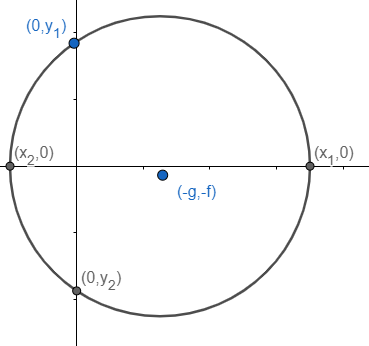Question
Question: The intercept made by the circle \({{x}^{2}}+{{y}^{2}}-5x-14=0\) . Find the radius circle. Does this...
The intercept made by the circle x2+y2−5x−14=0 . Find the radius circle. Does this circle exist in real? Justify your answer.
Solution
Hint:Compare the given equation with the standard equation of circle i.e. x2+y2+2gxf+2fy+c=0 where centre (-g, -f) and radius is calculated as g2+f2−c . And intercepts on x-axis and y-axis are given as 2g2−c,2f2−c respectively. General equation of conic i.e.
ax2+2hxy+by2+2gx+2fy+c=0
Will represent a circle if,
Δ=0,a=b,h=0
Value of Δ is given as:
Δ=abc+2fgh−af2−bg2−ch2 .
Complete step-by-step answer:
Given equation of the circle in the problem is
x2+y2−5x−14=0............(i)
As we know standard equation of a circle can be given by equation as
x2+y2+2gx+2fy+c=0............(ii)
Where (-g, -f) is the centre of the circle and g2+f2−c will give radius of the circle. And we also know the formula for the intercept made by the circle with equation given in equation (ii) as
‘x’ intercept by circle =2g2−c.............(iii)
‘y’ intercept by the circle =2f2−c...........(iv)
Now, we can get values of g, f, c by comparing the equation (i) and standard equation of circle represented in equation (ii). So, we get
g=2−5,f=0,c=−14
Now, we can put values of g, f, c with the equation (iii) and (iv) to get the values of intercepts. Hence we get intercept on x-axis
=2(2−5)2−(−14)=2425+4=2425+56=2481=2×29=9
So, the length of the intercept on the x-axis by the given circle is 9. Similarly we can get length of intercept on y-axis as intercept on y-axis
=2(0)2−(−14)=20+4=214
Hence, length of intercept on y-axis by the given circle is 214.
Now, we can calculate the radius of the circle with the help of relation g2+f2−c as radius of given circle
=(2−5)2+(0)2−(−14)=425+14=481=29
Hence, the radius of the given circle is 29 .
Now, we need to justify whether the given equation of conic will be a circle or not. General equation of conic is given as
ax2+2hxy+by2+2gx+2fy+c=0..........(v)
And it will represent a circle if Δ=0,h=0,a=b where Δ can be given as
Δ=abc+2fgh−af2−bg2−ch2.............(vi)
Now, compare the general equation of conic I equation (v) with the equation of circle given in equation (ii) and hence get
a=1,h=0,b=1,g=2−5,f=0,c=−14
Now, we can calculate values of Δ from the equation (vi) as
Δ=(1)(1)(−14)+2×0×(2−5)×0−1×02−1(2−5)2−(−14)02Δ=−14−425=4−81=0
Hence, we can get the conditions of the circle that Δ=0,a=b=1,h=0 . Hence, the given equation is representing a circle. It’s justified now.
Note: One may use (x−x1)2+(y−y1)2=r2 as well in place of x2+y2+2gx+2fy+c=0 where (x1,y1) is centre and r is radius.
x2+y2−5x−14=0⇒x2−5x+y2−14=0
Add (25)2 and subtract it as well. So, we get
x2−5x+(25)2−(25)2+y2−14=0⇒x2−2×25×x+(25)2+y2=14+(25)2(x−25)2+y2=14+425=481⇒(x−25)2+(y−0)2=(29)2
So, centre is (25,0) and radius is 29
Δ=abc+2fgh−af2−bg2−ch2
Can also be represented in determinant form as well. It is given as
Δ=a h g hbfgfc
The intercept formulae
2g2−c,2f2−c
Can be proved with the help of a standard form of circle as

x-intercept = ∣x1−x2∣ and y-intercept = ∣y1−y2∣ as we have equation as
x2+y2+2gx+2fy+c=0
Put x = 0 and get quadratic in ‘y’ and hence calculate ∣y1−y2∣ as y1,y2 will be the roots of that quadratic. And similarly, put y = 0 to the standard equation and get quadratic in ‘x’ to calculate ∣x1−x2∣ as x1,x2 will be the roots of that quadratic.
